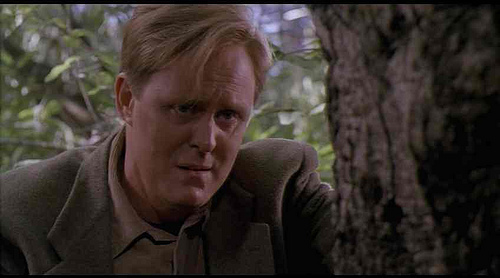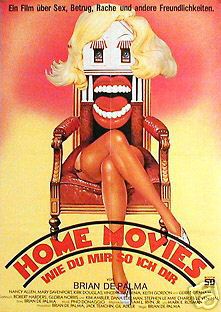CARRIE AND THE RUNAWAYS
ALSO BLUEBEARD; AND EDGAR WRIGHT ON THE GREATEST SCENE EVER SHOT
More than one critic has been reminded of
Brian De Palma's
Carrie while watching
The Runaways,
Floria Sigismondi's biopic about the real-life all-girl rock band, currently in theaters (the film still hasn't made it my way yet, so I have not seen it).
The Globe and Mail's Liam Lacey states that the film "opens with a quarter-sized spot of blood hitting a sidewalk." Lacey continues, "The sidewalk is on Los Angeles’ Sunset Strip, the blood is menstrual – perhaps a nod to Brian De Palma’s crypto-feminist horror movie
Carrie. Either way, it’s a declaration that this is teenaged girl territory."
Writing in the
New York Press,
Armond White notes that the "drop of menstrual blood at the beginning of
The Runaways recurs in
Bluebeard,
Catherine Breillat’s adaptation of the 17th-century
Charles Perrault fairytale." White adds that "for the cinema-savvy, Breillat’s film may also recall the opening sequence of Brian De Palma’s 1976
Carrie, where menstrual blood evokes shame and vengeance (same as in
The Runaways)." Comparing the two newer films, White writes:
Both blood images are bold, modern signs of female coming of age, but Breillat, like The Runaways’ director Floria Sigismondi, is also advancing a consciousness of female being that rarely makes it to the screen. (This is especially surprising— and welcome—coming right after Kathryn Bigelow gets rewarded for fitting into the status quo rather than challenging it.) The best way to understand Breillat’s very free fairytale adaptation might be to appreciate its aggressive, almost punk-rock, impudence: Breillat uses female blood for an extraordinary, unnerving finale that climaxes the film’s confrontation with erotic myths that are taught to us—via religion and art—since childhood.
Click here for Armond White's review of The Runaways, in which he compares
Michael Shannon's androgynous overplayed performance as producer
Kim Fowley to that of
Gerrit Graham’s Beef in De Palma's
Phantom of the Paradise.
CARRIE AS ADULT FAIRY TALE
Speaking of fairy tales, Susan Kim, co-author of Flow: The Cultural Story of Menstruation, mentioned last December in an article for the Huffington Post that De Palma's Carrie "is one of the most whoppingly effective fairy tales ever made for adults." Kim continues:
It's a Gothic horror story, a supernatural fable about menstruation, the taboos surrounding it, and the power it can unleash -- filtered through a Roman Catholic sensibility and juxtaposed against 70s American suburbia. To some, it's a cheesey camp-fest; to me, it's one of the best horror films ever made and, I bet, probably the only one about primary amenorrhea.
Finally, Brenda at Moot Point saw both Carrie and The Runaways last weekend, and points out that the films are both set in the mid-seventies (Carrie was released in 1976, while The Runaways takes place in 1975). Brenda writes, "Both of them are about different ways the power of womanhood runs away with the main characters. I don’t think it’s a coincidence that Sigismondi chose to start The Runaways with that image, also." While Carrie, according to Brenda, shows that "menstruation and therefore the female body are scary and monstrous," The Runaways presents a different perspective. "In the hands of a lady filmmaker making a movie about lady culture," writes Brenda, "the period is no longer a source of supernatural horror. It’s just a pain in the ass."
WRIGHT ON CARRIE: "THE GREASE OF HORROR MOVIES"
Last month, Edgar Wright was one of several filmmakers contributing to The Guardian's "The Greatest Film Scenes Ever Shot." Wright chose the "Blood at the Prom" scene from Carrie. Here is what he said about the scene:
I always describe Carrie as the Grease of horror movies: it resonates with all ages because everybody remembers their awkward teenage phase and can watch it and say – I was the bully or the victim or the person who did nothing. It explores how apocalyptic your rage can be as a teenager. Carrie's not a killer, she's a girl who has been bullied and through a terrible confluence of events ends up burning the school down. It's also unusual for a horror film. It doesn't have someone being killed every 20 minutes and then a climax – it builds to one huge climax at the prom. School bullies have fixed the prom so that Carrie White will win and they can humiliate her by tipping a bucket of pig's blood over her in front of the whole school. The scene and the excruciating build-up to it is one of the greatest set pieces of all time, full of suspense, with a monumental payoff.
A crane shot sets up the sequence so you know where everyone is positioned and that the bucket of blood is above Carrie and Tommy's heads. Once the plot is set in motion Pino Donaggio's score takes over. The resulting sequence is pure opera.
I first saw Carrie on VHS with my brother's friend when I was about 12. I obsessively read about horror movies and was dying to see it. I've watched it so many times since. De Palma planned the sequence for months and battled the studio over the time spent on filming it. But it was worth the blood, sweat and tears. It still leaves audiences speechless.
HI, MOM!/TAXI DRIVER NOTED IN "GREATEST SCENES"
Also in the Guardian article, producer Stephen Woolley chooses the mirror scene from Martin Scorsese's Taxi Driver, and recalls watching De Palma's Hi, Mom!, which was made five years earlier, and thinking, "I can't believe it – the thing he does in Taxi Driver!"
 It's A Wonderful Afterlife is said to be a film that puts several genres into a blender with uproarious results. Director Gurinder Chadha talked to The Northern Echo's Steve Pratt about how she came up with the idea to bring the house down at a London-set Indian wedding by bringing in a bit of Brian De Palma's Carrie. Carrie had a "huge impact" on Chadha, according to Pratt, as the first horror film she'd ever seen. Here's how she tells it to Pratt:
It's A Wonderful Afterlife is said to be a film that puts several genres into a blender with uproarious results. Director Gurinder Chadha talked to The Northern Echo's Steve Pratt about how she came up with the idea to bring the house down at a London-set Indian wedding by bringing in a bit of Brian De Palma's Carrie. Carrie had a "huge impact" on Chadha, according to Pratt, as the first horror film she'd ever seen. Here's how she tells it to Pratt:




 Film projects come along every now and then that seem perfectly fit for someone like Brian De Palma. For instance, when I read the news this past week about Scarlett Johansson and Sam Rockwell being signed to star in a formerly lost Stanley Kubrick project, the dark mystery Lunatic At Large, it immediately struck me that the material seemed suitable for De Palma (who also seemed to have had a solid working relationship with Johansson on The Black Dahlia a few years ago).
Film projects come along every now and then that seem perfectly fit for someone like Brian De Palma. For instance, when I read the news this past week about Scarlett Johansson and Sam Rockwell being signed to star in a formerly lost Stanley Kubrick project, the dark mystery Lunatic At Large, it immediately struck me that the material seemed suitable for De Palma (who also seemed to have had a solid working relationship with Johansson on The Black Dahlia a few years ago).  More than one critic has been reminded of Brian De Palma's Carrie while watching The Runaways, Floria Sigismondi's biopic about the real-life all-girl rock band, currently in theaters (the film still hasn't made it my way yet, so I have not seen it).
More than one critic has been reminded of Brian De Palma's Carrie while watching The Runaways, Floria Sigismondi's biopic about the real-life all-girl rock band, currently in theaters (the film still hasn't made it my way yet, so I have not seen it).  According to
According to 



